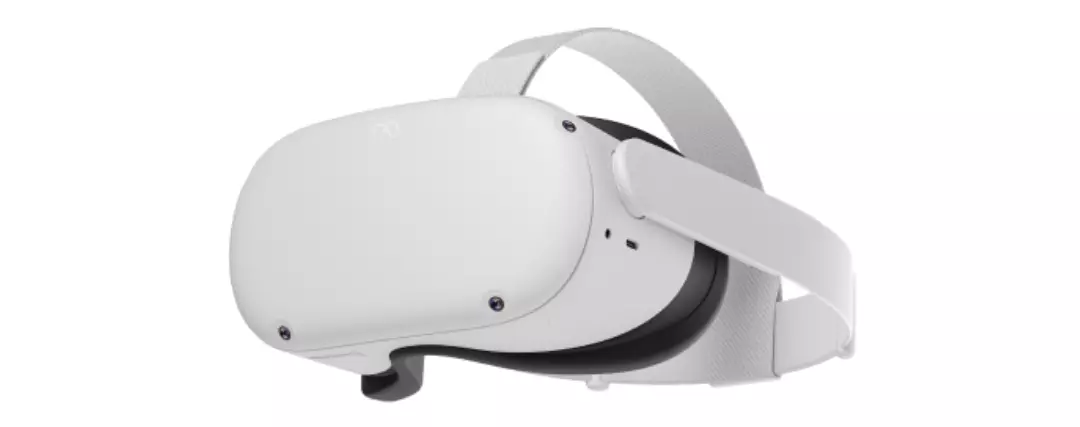Exploring Meta Quest 2: A Game-Changer in Virtual Reality Technology
Posted on June 16, 2023 26 minutes 5461 words
Table of contents
- Embracing the Metaverse: A Dive into Meta Quest 2
- Meta Quest 2: A Detailed Look at the Game-Changing VR Headset
- Meta Quest 2: An In-Depth Exploration of the VR Headset’s Hardware
- Meta Quest 2: Software and User Experience
- Meta Quest 2: Standout Features That Set It Apart
- Meta Quest 2: Unveiling the Performance and Gaming Experience
- Meta Quest 2: The Future of VR Gaming for Developers
- The Future of VR and Meta Quest: A Discussion
- Concluding Thoughts: The Meta Quest 2 and the Future of VR
- References
Embracing the Metaverse: A Dive into Meta Quest 2
Meta: The Company Creating Our Collective Virtual Future
The 21st century has seen the rise of numerous technology giants, each with their unique contribution to the digital transformation of our lives. Among these behemoths, Meta Platforms, formerly known as Facebook, stands out as a unique blend of innovation, vision, and foresight. Established as an American multinational technology conglomerate, Meta is headquartered in Menlo Park, California. It owns and operates several popular social media platforms that have become integral parts of our digital culture, including Facebook, Instagram, and WhatsApp.
Ranked among the world’s most valuable companies and the ten largest publicly traded corporations in the United States, Meta has shown its relentless ambition to continually push the boundaries of what technology can do. The transformation from Facebook, Inc., to Meta Platforms, Inc., on October 28, 2021, was more than just a name change; it was a testament to the company’s focus on building a new digital reality, the metaverse.
In essence, the metaverse is an integrated environment that connects all of Meta’s products and services, representing a hybrid of today’s online social experiences, sometimes enhanced into three dimensions or even projected into the physical world. By spearheading the development of the metaverse, Meta aims to help people connect, find communities, and grow businesses more dynamically and interactively. With their widespread business presence, spanning across the Americas, Europe, the Middle East, Africa, and Asia-Pacific, Meta is undeniably shaping the course of our digital future.
The Revolutionary World of Virtual Reality
Virtual Reality (VR) is a simulated experience that can be similar to or completely different from the real world. It utilizes computer technology to create an immersive environment that makes the user feel as if they’re physically present in that simulated world. The illusion of ‘being there’ is created through a combination of interactive hardware and software. Most commonly, users wear a VR headset that tracks their motion and changes the images they see inside the headset accordingly.
The concept of VR has been around for several decades, but only in the 21st century have technological advancements made it accessible and enjoyable for the average consumer. Applications of VR include entertainment (i.e., gaming), education (i.e., medical or military training), and business (i.e., virtual meetings).
Meta’s Quest Line of Products: Shaping the VR Landscape
The Quest line of products is part of Meta’s ongoing effort to push the boundaries of VR technology. The original Oculus Quest, launched in 2019, marked a significant leap forward in the consumer VR industry. It was one of the first VR headsets to offer six degrees of freedom (6DoF) tracking without the need for external sensors, making for a more immersive and convenient user experience.
The Quest headsets are standalone devices, meaning they don’t require a connection to a PC or console to function. This has made high-quality VR experiences more accessible than ever, allowing users to enjoy VR gaming and applications in any room of their home without requiring expensive additional hardware.
The Quest line represents Meta’s belief in the potential of VR technology not just as a gaming platform, but as a new way for people to work, learn, and connect with each other. With each iteration, these headsets aim to improve on the last, providing a more immersive, realistic, and socially connected VR experience.
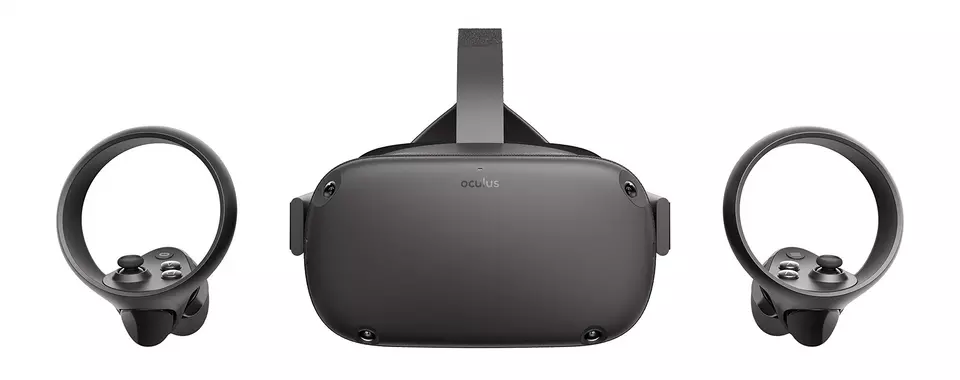
Meta Quest 2: A Detailed Look at the Game-Changing VR Headset
Release Date and Basic Specifications of Meta Quest 2
Heralding a new era of virtual reality (VR), Meta Platforms, formerly known as Facebook, Inc., introduced the Meta Quest 2 to the world on September 16, 2020, and subsequently released it on October 13, 2020. Developed by Meta’s Reality Labs, this all-in-one VR headset emerged as a robust, feature-rich platform for immersive experiences, from gaming to education, medicine, and business.
Under the hood, the Meta Quest 2 houses a powerful Qualcomm Snapdragon XR2 system-on-a-chip, alongside 6 GB of LPDDR4X memory and storage options that include 64 GB, 128 GB, or 256 GB. To deliver crystal-clear visuals, the Quest 2 sports an RGB LCD display with a resolution of 1832 x 1920 per eye, capable of refresh rates between 72 to 120 Hz.
Tracking in the virtual space is enabled through the device’s 6DOF inside-out tracking system, courtesy of four built-in cameras and two controllers outfitted with accelerometers and gyroscopes. In 2022, the Oculus Quest 2 was rebranded as Meta Quest 2 as a part of the company-wide phase-out of the Oculus brand. The launch of the Meta Quest 3, the next iteration of this innovative VR headset, has been announced for Fall 2023, promising higher resolution, superior performance, and Meta’s cutting-edge reality technology packaged within a more streamlined and comfortable design.
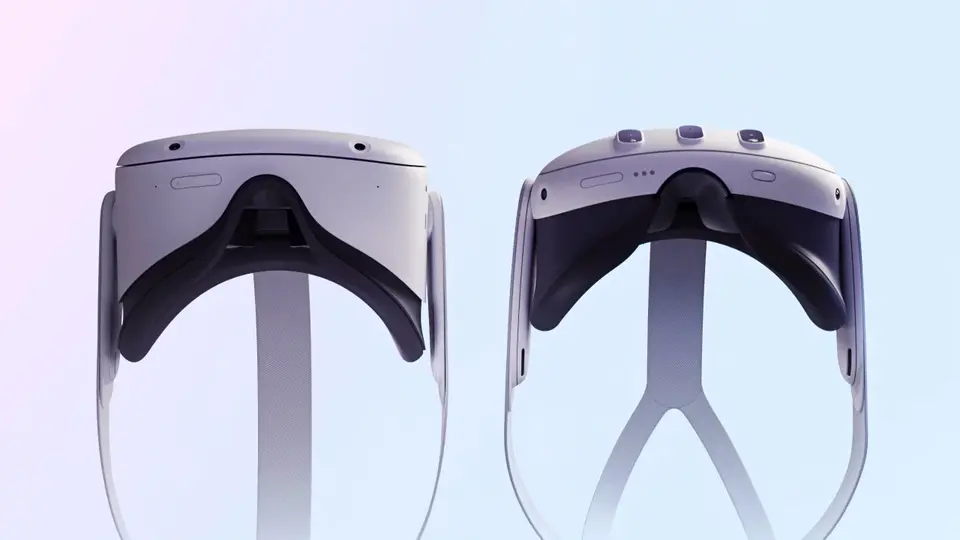
Physical Design and Improvements over the Previous Version
The Meta Quest 2 represents a significant leap in the design and capabilities of VR headsets. As an all-in-one VR headset, it operates independently without needing a separate gaming PC. This freedom of use is enhanced by the device’s hand-tracking capabilities, allowing users to navigate menus even without controllers. For those seeking more demanding gaming experiences, the headset can be connected to a PC using a separate accessory.
Improving upon its predecessor, the Meta Quest 2 features a higher resolution display of RGB LCD 1832 x 1920 per eye, and its refresh rate cap has been increased to 120Hz. This means that supported games can offer smoother motion, reducing the risk of motion sickness. The Meta Quest 2 is also lighter and sharper, boasting a faster processor, all offered at a more competitive price point.
While the new Meta Quest Pro model offers advanced features such as eye tracking, mixed reality, and color passthrough, the Meta Quest 2 remains a formidable choice for the average gamer seeking a high-quality, wireless VR headset. Furthermore, the upcoming Meta Quest 3, slated for release in Fall 2023, will present an even more refined VR experience, featuring higher resolution, stronger performance, Meta’s groundbreaking Reality technology, and a slimmer, more comfortable form factor.
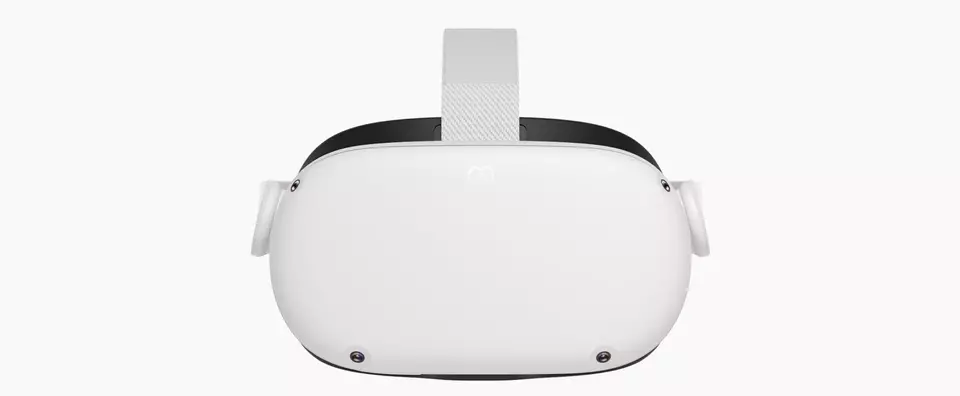
Price and Availability
As of June 2023, the Meta Quest 2 is now even more accessible, with the 128GB version now priced at $299.99 USD. The 256GB version of the Meta Quest 2 is currently available for $349.99 USD.
The Meta Quest 2 is readily available for purchase in various global markets, including the United States and the United Kingdom. The next-generation VR headset, the Meta Quest 3, is set for release in Fall 2023, with a starting price of $499.99 for the 128GB SKU. As the VR landscape continues to evolve, Meta continues to push the boundaries, offering more accessible, powerful, and immersive experiences for users worldwide.

Meta Quest 2: An In-Depth Exploration of the VR Headset’s Hardware
Display and Visual Quality
The Meta Quest 2 sets itself apart with its impressive display resolution of RGB LCD 1832 x 1920 per eye, presenting a noticeable enhancement over its predecessor. Its support for a 120Hz refresh rate, an upgrade from the original Quest’s 72Hz, translates to smoother and more immersive visuals.
While the newer Meta Quest Pro boasts a superior display quality with 37% more pixels, a larger clarity ‘sweet spot’ due to innovative pancake lenses, and local dimming delivering a contrast 75% greater than the Quest 2’s, the latter remains commendable for its sharpness. The Meta Quest 2’s lenses are circular while its screen is rectangular, effectively trimming down the corners to reduce bulk.
The headset’s higher resolution leads to a marked improvement in visual quality, with everything appearing sharper compared to the original Quest. Although the Quest 2’s 21 pixels per degree don’t reach the ‘retinal’ resolution of 60 pixels per degree generally attributed to the human eye, the density of the pixels within the same area reduces the gaps between pixels, making them less noticeable and maintaining a visually immersive experience.
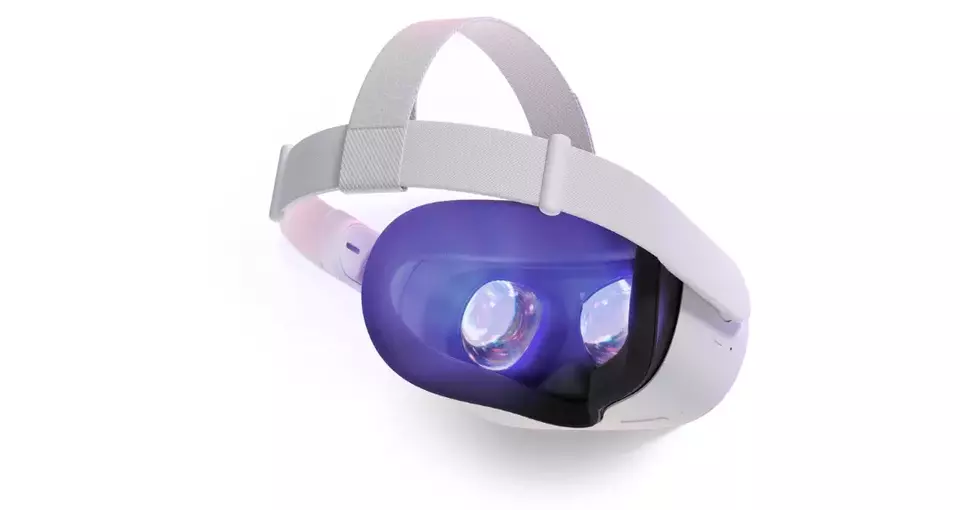
Audio Technology of Meta Quest 2
Sound is an integral part of VR experiences, and the Meta Quest 2 has this covered with its built-in speakers that channel audio to the user’s ears via the headband arms. Although the sound is open and can be heard by others nearby, a headphone socket allows for private listening through your own headphones or earbuds.
Logitech has introduced an accessory called Chorus specifically for the Meta Quest 2, providing an enriched, immersive audio experience. Chorus offers off-ear audio integration for a more realistic sound experience while maintaining the user’s awareness of their surroundings. Priced at $99.99 USD, these speakers available on Logitech’s website or Amazon, offering a seamless integration into the Quest 2’s design.
Controllers of Meta Quest 2
The Meta Quest 2 comes equipped with a pair of Meta Quest 2 Touch controllers, sold separately at $74.99 USD. These controllers provide users with a sense of ‘hand presence,’ allowing them to interact with the virtual environment through buttons, triggers, and joysticks. They are wireless and communicate with the headset via Bluetooth.
Additionally, the Meta Quest 2 features an experimental ‘Direct Touch’ option that lets users interact in the virtual environment with their bare hands - tapping buttons, swiping through the game library, and even typing messages on a virtual keyboard without the need for controllers.
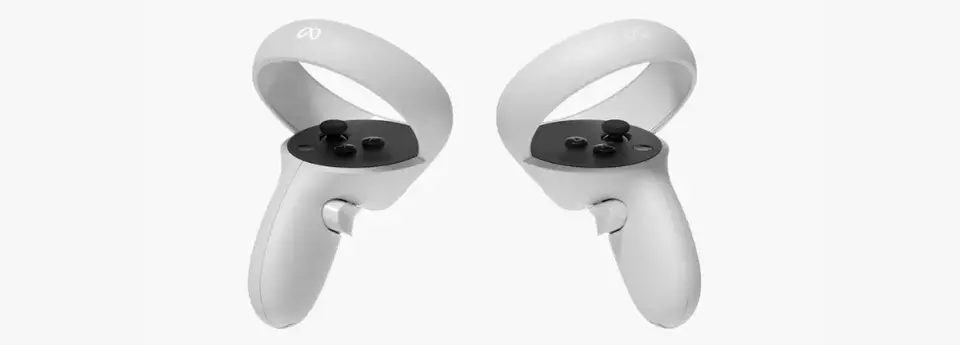
Battery Life and Charging of Meta Quest 2
The Meta Quest 2 offers a battery life of two to three hours, depending on usage, which can be extended using power-saving tricks like turning off the headset when not in use. It takes approximately 2.5 hours to reach a full charge, and it’s recommended not to leave the headset plugged in after it’s fully charged as this can degrade the internal battery’s maximum capacity over time.
For extended storage, it is advised to leave the battery charged to around 50% and store the device at room temperature. You can also prolong the battery life by using an external battery pack or the included two-meter charging cable.
Comfort and Wearability of Meta Quest 2
The Meta Quest 2, like any wearable tech, can become uncomfortable during prolonged use. However, several solutions can enhance its wearability:
-
Upgrading the head strap: The default strap can be replaced with more comfortable third-party options that distribute the headset’s weight more evenly.
-
Replacing the facial interface: Meta now includes a removable silicone cover for the foam base, but a more comfortable and hygienic alternative can be found in VR Cover’s replacement facial interfaces.
-
Adjusting the lenses: Fine-tuning the Quest 2’s lenses to your eyes can greatly improve the overall comfort.
-
Using an external battery pack: This can extend the battery life and, by adding a little weight to the back, can help balance the headset for a more comfortable fit.
In comparison, the Meta Quest Pro, Meta’s new work-centric headset, boasts a more ergonomic design with a halo-style strap for comfort. It also offers an enhanced visual experience with a higher resolution screen, more pixels, and a larger area of maximum clarity due to its innovative pancake lenses.
Overall, the Meta Quest 2 remains a reliable VR headset, with its affordability and performance making it a great choice for most users, despite the arrival of more advanced models.
Meta Quest 2: Software and User Experience
Overview of the Meta Operating System and User Interface
At the heart of the Meta Quest 2 is an operating system rooted in Android 12.1, complete with a proprietary interface and app store distinct from the traditional Android ecosystem. The immersive user interface (UI) crafted specifically for the Meta Quest 2 enables a seamless transition into the world of virtual reality, favoring intuitive controls and an environment-oriented design over a complex, overbearing structure.
Meta has revamped its system interface for the Meta Quest Pro, bringing an array of improvements that are also accessible to Meta Quest 2 users. This upgrade offers a gentler color palette, smoother animations, more responsive controls, and an easier-to-read typeface.
Meta Quest 2’s UI is characterized by its simplicity, offering quick access to apps and games through an uncluttered menu system. It provides a customizable environment, allowing users to arrange apps and games to their liking. Above all, the user interface champions a 3D, interactive environment that fosters immersion and discovery. With clear, legible icons and text, the Quest 2’s interface assures effortless navigation, so you can spend less time figuring things out and more time exploring.
The Setup Process of Meta Quest 2
Setting up the Meta Quest 2 is a straightforward process. You’ll first unbox the device, then download the Meta app on your smartphone. Creating a Meta account is next, followed by pairing your headset to your phone via Bluetooth using the Meta app. Put on your Meta Quest 2 and follow the on-screen instructions to connect it to Wi-Fi. The headset will then start updating its software – a process that requires keeping the Meta app open.
In approximately 10-15 minutes, the Meta Quest 2 is ready to take you on VR adventures. While the setup process is straightforward, plenty of resources are available online to assist users who may encounter hiccups along the way.
Notable Applications or Games on Meta Quest 2
The Meta Quest Store offers a plethora of VR experiences that can be purchased and installed directly onto the headset. Additionally, the Meta Quest mobile app allows for browsing and purchasing games without having to don your headset.
Here are some notable free games and apps that new Quest 2 owners can download:
- First Steps
- Rec Room
- Echo VR
- Beat Saber Demo
- Superhot VR Demo
- The Climb Demo
- Bait!
- Bigscreen Beta
- PokerStars VR
- VRChat
- Wander
- Racket: Nx Demo
- Blaston Demo
Purchasing and Installing New Applications or Games on Meta Quest 2
Buying and installing new games or applications on the Meta Quest 2 is a simple task that you can perform either via the Meta Quest mobile app or directly on your headset. Here are the steps to follow:
- Create a Meta account and download the Meta Quest app on your smartphone.
- Open the app and tap on “Store” at the bottom.
- Browse the games and apps, then select the one you want to purchase.
- Tap the price of the app or game to buy it, or “Free” if it’s a free app.
- Proceed to payment via PayPal or credit card.
- Turn on the Meta Quest 2 and connect it to Wi-Fi.
- The headset will automatically download and install the game or app you’ve purchased.
Alternatively, you can purchase and install games and apps directly on the Meta Quest 2:
- Turn on your headset and connect it to Wi-Fi.
- Press the oval Meta button on your right Touch controller to open the menu.
- Navigate to the “Store” and browse the available games and apps.
- Select the one you want to purchase and proceed to payment.
- After successful payment, your headset will download and install your new game or app.
If you encounter any issues during this process, you’ll find plenty of resources online to guide you through. Welcome to the incredible world of Meta Quest 2!
Meta Quest 2: Standout Features That Set It Apart
In the rapidly expanding realm of virtual reality, Meta’s Quest 2 stands out with a suite of unique features and advancements over its predecessor that make it a strong contender in the market. Here, we take a closer look at what differentiates the Meta Quest 2 in terms of features and its integration with social media and other Meta platforms.
Unique Features of Meta Quest 2 Compared to Competitors
While the VR market is teeming with robust offerings, Meta Quest 2 shines with some unique aspects that give it a competitive edge. Its all-in-one design eliminates the need for a separate gaming PC, providing users with an unhampered, easy-to-setup VR experience. Add to this the hand-tracking capabilities that let users navigate menus without controllers, and you have a device that’s designed for intuitive interaction.
One of the biggest draws of the Meta Quest 2 is its high 120Hz refresh rate, which outpaces its competitors to offer a smoother, more realistic virtual experience. The customizable user interface lets users organize their apps and games to suit their preferences, adding an extra layer of personalization.
A standout feature is the optional external battery pack that can extend the life of the device, ensuring users are never left mid-adventure due to power constraints. Meta’s experimental feature, “Direct Touch,” allowing users to interact with the VR environment using their bare hands, is also exclusive to Quest 2.
Significantly, the device can be tethered to a PC using a separate accessory, unlocking access to more demanding games, expanding its usability for hardcore gamers. The upcoming Meta Quest Pro’s unique features further push the envelope with a higher resolution screen, greater contrast, and a more vibrant display.
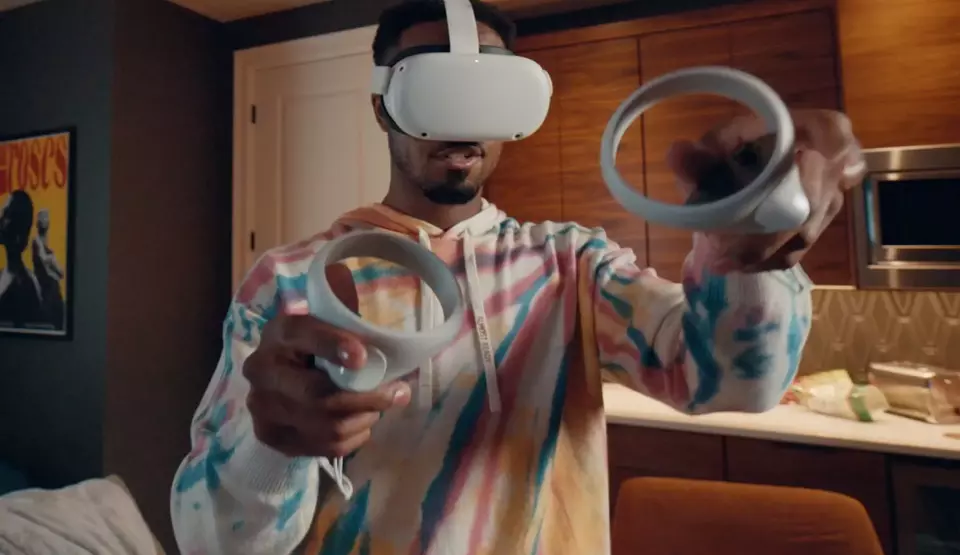
Innovations of Meta Quest 2 Compared to the Original Quest
Since its original Quest, Meta has introduced several innovations in the Quest 2. The device’s resolution has been significantly increased, resulting in sharper, clearer visuals. Coupled with a higher refresh rate, these improvements ensure a smoother, more immersive VR experience.
Hand-tracking capabilities are now a part of the Meta Quest 2, making controller-less navigation a reality. The “Direct Touch” feature furthers this, allowing users to interact with the virtual world more intuitively. An external battery pack can extend the Quest 2’s playtime, and PC compatibility has been introduced, allowing users to enjoy more graphically intensive games.
In short, the Meta Quest 2 represents a substantial upgrade from the original Quest, offering an array of features that enhance the immersion and enjoyment of the VR experience.
Integration of Meta Quest 2 with Social Media and Other Meta Platforms
One of the primary goals of Meta Quest 2 is to make VR a social experience. To this end, it has integrated the device with various social media platforms and Meta services. This integration allows users to connect with friends and family in the metaverse, making VR experiences more shared and interactive.
Annual events like Meta Connect help highlight the latest developments and demonstrate how VR is becoming increasingly social. The distribution of beta VR versions of Facebook and Instagram on the Quest storefront is another step towards integrating the social media experience with VR.
Furthermore, the Meta Quest app allows users to manage their device and browse games and apps remotely, adding to the convenience. The Meta Quest Store brings hundreds of VR experiences to users’ fingertips, which can be installed remotely on the headset. Integration with platforms like SteamVR (when tethered to a PC) gives users access to a plethora of gaming experiences.
In conclusion, Meta Quest 2 serves up a compelling mix of innovative features and enhanced integration with social media and other platforms, truly embodying Meta’s vision of an immersive, interactive metaverse.
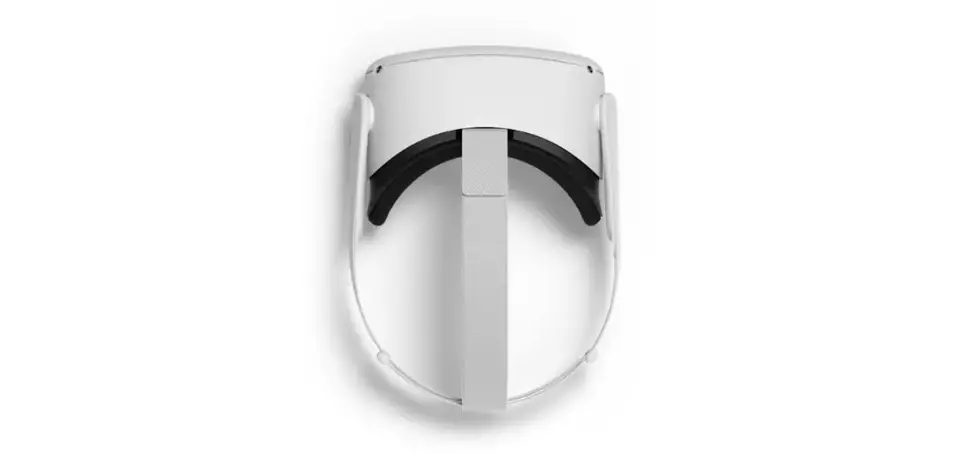
Meta Quest 2: Unveiling the Performance and Gaming Experience
Virtual Reality (VR) has long ceased to be the stuff of science fiction, and the Meta Quest 2 stands as a testament to the immense progress in this arena. Let’s delve into the performance capabilities of this VR headset and how popular games and applications run on it. We’ll also explore the multiplayer and social features that heighten the VR experience.
Unpacking Meta Quest 2’s Performance Capabilities
he Meta Quest 2 is built to impress with its cutting-edge performance features. The headset sports a CPU and GPU performance boost of 26% and 19% respectively, ensuring a speedy, efficient VR experience. This enhancement, coupled with GPU overclocking, significantly improves frame rates for smoother gameplay.
Under the hood, the device is powered by a Snapdragon XR2 chip, purpose-built for VR headsets. This results in superior performance compared to the original Quest’s Snapdragon 835 CPU. Adding to the efficient operation is 6GB of RAM, allowing for quick and smooth menu navigation.
Battery life is a significant factor for any wireless device, and the Meta Quest 2 doesn’t disappoint, offering 2-3 hours of playtime. This can be further extended with an external battery pack or the two-meter charging cable included in-box. With these formidable performance capabilities, Meta Quest 2 proves itself to be a force to reckon with in the VR headset market.
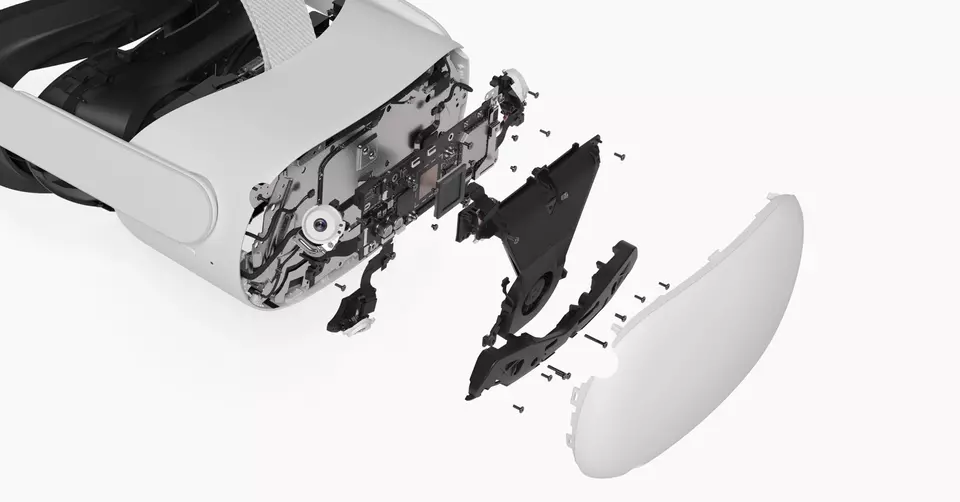
Meta Quest 2: Games and Applications Under the Spotlight
The Meta Quest 2 boasts a comprehensive library of games and applications available through the Meta Quest Store. Here are some popular examples showcasing the device’s prowess:
“Beat Saber” stands as a fan-favorite rhythm game, having users cut through blocks in sync with music. It offers a fluid gameplay experience on the Meta Quest 2. “Moss,” an action-adventure game, also runs seamlessly on the device, enhancing the magic of its fantasy world. For those craving action, “Superhot VR” provides an immersive slow-motion bullet-dodging experience, making full use of the device’s capabilities.
For those seeking non-gaming applications, “YouTube VR” offers an innovative twist to content consumption by enabling users to watch videos in a 3D environment. “First Steps” serves as an ideal introduction to the device, comprising various mini-games that highlight the Meta Quest 2’s capabilities.
Virtual reality apps like “Bigscreen Beta” and “Painting VR” turn watching movies and creating art into immersive, interactive experiences, further showcasing the versatility of the Meta Quest 2.
Embracing Social Features with Meta Quest 2
Meta Quest 2 isn’t just about single-player experiences. The device opens up an array of multiplayer and social features, making VR a more shared and connected experience. A wide selection of multiplayer games facilitates virtual interaction with other users.
Notably, after years of anticipation, local multiplayer support is now a reality. Users can invite friends through the People menu to engage in multiplayer games or simply chat in the virtual realm.
“Meta Horizon Home” acts as a social hub where users can hang out, watch movies together, and even launch multiplayer games directly from within Meta Quest 2. Additionally, the annual Meta Connect event showcases Meta’s latest Virtual Reality and Augmented Reality innovations, fostering a sense of community among users.
In conclusion, the Meta Quest 2 is a remarkable blend of performance capabilities, rich gaming and application offerings, and engaging social features. It’s clear that the future of VR is here, and it’s immersive, powerful, and incredibly social.
Meta Quest 2: The Future of VR Gaming for Developers
Immersive gaming experiences hinge heavily on the versatility and capability of their hardware. In the realm of virtual reality, Meta Quest 2 has established itself as a robust platform not just for gamers, but for developers as well. In this article, we’ll explore the development platform of Meta Quest 2, highlight some outstanding third-party applications and games, and discuss the exciting potential the platform holds for future developments.
Navigating the Development Platform for Meta Quest 2
Meta Quest 2’s development platform is designed with developer convenience in mind, providing an array of features and tools to design and create immersive VR experiences. The customizable user interface allows developers to tailor their workspace according to their preferences.
Operating on a system based on Android Open Source Project (AOSP) source code, Meta Quest 2 encourages interactive applications with its hand-tracking capabilities, enabling navigation sans controllers. The platform’s vast library of multiplayer games, coupled with its social features, empowers developers to create engaging, communal VR experiences.
To facilitate the creation of these experiences, developers have access to multiple development tools, including the Meta SDK, Unity, and Unreal Engine. These tools, when harnessed, allow for an easy, streamlined approach to game and application creation on the Meta Quest 2 platform.
Standout Third-Party Applications and Games for Meta Quest 2
The Meta Quest 2 platform offers a vast collection of third-party games and applications that showcase the device’s capabilities. Here are some standouts:
-
Beat Saber: This rhythm game, where players slice through blocks with lightsabers, is a fan favorite, running smoothly and providing a stellar gaming experience.
-
Moss: An action-adventure game that beautifully leverages VR capabilities, offering an enchanting journey through a magical world.
-
Superhot VR: This game’s slow-motion, bullet-dodging gameplay wonderfully exhibits the device’s capabilities.
-
YouTube VR: This app allows users to view their favorite YouTube content in a 3D environment, adding an immersive layer to standard video consumption.
-
First Steps: This collection of mini-games introduces users to VR and showcases the capabilities of the Meta Quest 2.
-
BRINK Traveler: This application lets users virtually travel the world in a 3D environment.
-
Kingspray Graffiti & Gravity Sketch: These creative applications allow users to create graffiti and 3D models, respectively, in a VR environment.
-
TRIPP: A meditation app that offers users a tranquil space to relax and meditate in VR.
This vast array of applications and games exemplifies the versatility and capability of the Meta Quest 2 platform, offering a breadth of experiences to the users.
Looking Ahead: Meta Quest 2’s Potential for Developers
The future appears bright for developers on the Meta Quest 2 platform. The graphical potential of the device is far from being fully exploited, with room for visually stunning and more complex game developments.
Meta has recently updated the system interface for the Meta Quest Pro, a change that will also benefit Meta Quest 2, offering an improved interface for developers. The device’s recent GPU overclocking update also boosts performance, allowing developers to create more demanding applications that can run efficiently on the device.
The development tools offered by Meta Quest 2 are continually being updated and improved, opening up new possibilities for immersive VR experiences. Chris Pruett, Director of Content Ecosystem, has announced that 150 new third-party titles are currently in development for the Meta Quest 2. As this library expands, developers will have more inspiration to draw from for their own creations.
The device’s social and multiplayer features also offer exciting opportunities for developers to create communal and shared VR experiences. The development potential of Meta Quest 2 is immense and promises an exhilarating future for VR gaming and application development.
In conclusion, Meta Quest 2 not only offers a phenomenal VR experience to its users but also provides a robust, intuitive platform for developers. As the platform evolves, it continues to create unprecedented opportunities for innovative and engaging VR content. The future of VR gaming is here, and it is brimming with potential.
The Future of VR and Meta Quest: A Discussion
The advancement in VR technology has heralded a new era of digital engagement, with Meta leading the charge through their Quest line of products. This article aims to discuss the future plans for the Quest line, Meta’s overall strategy for VR, and potential future developments in the wider VR industry.
The Quest’s Journey: Updates and Future Plans
Meta’s continual strides in advancing VR technology are evident in the updates and future plans for the Quest line of products. A recent announcement revealed the upcoming release of the Quest Pro, a high-end device tailored for business and research purposes.
The company has also confirmed plans for two new consumer-oriented Quest devices in 2023 and 2024. With prices estimated between $500 and $600, the next Quest VR headset promises an improved VR experience.
Meta is also working on a significant interface update for the Quest 2 and its upcoming product, Cambria, aiming to enhance the user experience further. This update, along with a performance boost, will provide developers with an elevated platform for more visually appealing and immersive games.
But that’s not all. Meta’s Reality Labs division is relentlessly innovating, with several VR headset prototypes in the works. These developments and updates underline Meta’s commitment to evolving the VR experience and solidifying their foothold in the market.
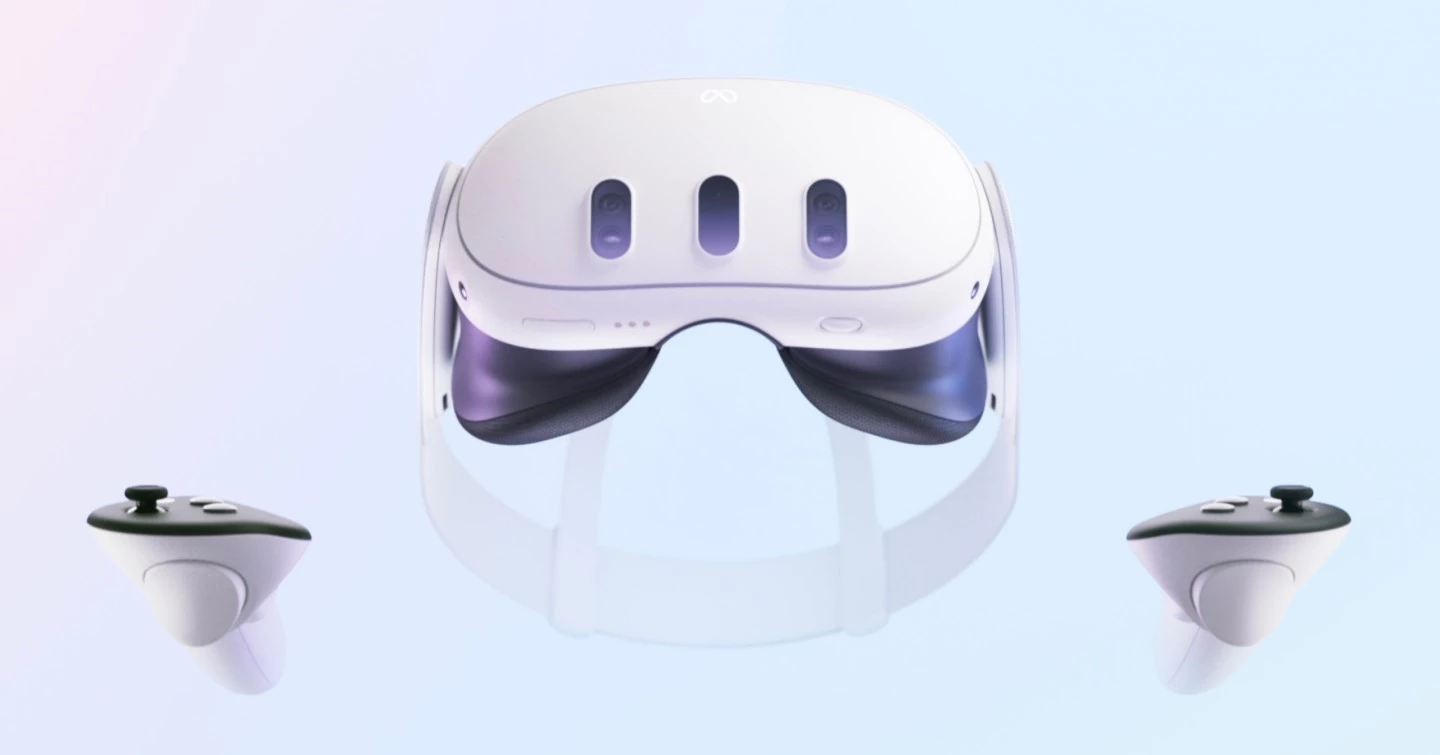
Meta’s Strategy: Crafting a Virtual Universe
Meta’s strategy for VR goes beyond hardware development. Their overarching goal is the creation of a metaverse - a virtual universe where users can interact, learn, work, and play in an immersive 3D environment.
Having invested nearly $10 billion in VR, Meta’s CEO, Mark Zuckerberg, is banking the company’s future on this technology. The focus remains firmly on VR, as seen in their emphasis on VR headsets and the delivery of immersive experiences within their envisioned 3D VR world.
This is not to say that Meta is turning a blind eye to augmented reality (AR). The company has detailed plans to release its first comprehensive AR glasses by 2027. This announcement, coupled with the success of the affordable, convenient, and accessible Quest line, underlines Meta’s broader strategy. Despite fierce competition from tech giant Apple, Meta aims to continue its domination of the VR headset market through lower-cost hardware without compromising on user experience.
The Future of the Wider VR Industry
The VR industry is rapidly evolving, and several potential future developments are on the horizon. One significant development is the expected increase in VR game revenues, which are projected to grow sixfold over the next five years.
Social VR platforms are gaining popularity, allowing users to interact in real-time within virtual environments. Businesses are also increasingly utilizing VR for training, remote collaboration, testing, and prototyping. With the metaverse concept gaining traction, there’s a substantial opportunity for growth in this sector.
As VR technology continues to improve, we can anticipate the emergence of advanced VR headsets with 8K resolution and faster data transmission speeds, thanks to the future 6G networks.
In summary, the future of VR and the Meta Quest line of products is promising. The continual advancements in technology and user engagement present endless opportunities for VR and AR applications. As Meta strides towards creating a comprehensive metaverse, the future of immersive, digital interaction appears bright and full of potential.
Concluding Thoughts: The Meta Quest 2 and the Future of VR
Summary and Overall Impressions of the Meta Quest 2
The Meta Quest 2, developed by Meta (formerly Facebook), is a standout player in the current VR landscape. Since its launch in 2020, the headset, featuring a per-eye resolution of 1832 x 1920 and a 120 Hz refresh rate, has been celebrated for its impressive performance and accessibility.
This all-in-one VR headset can be used virtually anywhere, contributing to its widespread appeal. Its extensive library of games and applications, paired with its robust social and multiplayer features, makes the Meta Quest 2 a comprehensive platform for immersive VR gaming and experiences. These qualities align it seamlessly with Meta’s vision for the future of VR: the metaverse, a vast, virtual world where individuals can work, learn, and play.
The Meta Quest 2: Beneficiaries
Akin to a multifaceted gem, the Meta Quest 2 shines brightly for both developers and users. Gamers seeking a unique, immersive VR experience would find the headset’s high resolution and refresh rate, improved performance, and hand-tracking capabilities especially captivating. Its affordable price, light weight, and portability, combined with the freedom of a standalone device, make it an excellent choice for gaming enthusiasts.
On the other hand, businesses looking to incorporate VR into their practices could significantly benefit from the Meta Quest 2. The device’s features lend themselves well to applications in training, remote collaboration, and testing and prototyping. From training employees in risk-free, simulated scenarios to fostering teamwork in a virtual space, the Meta Quest 2 opens the door to a multitude of possibilities.
Thus, whether you’re a gamer or a business professional, the Meta Quest 2, with its diverse applications and affordability, makes it a viable and compelling option to consider.
Final Thoughts and Future Outlook
The Meta Quest 2 has cemented its place in the VR landscape and continues to hold enormous potential for both users and developers. Its convenience, versatility, and expansive array of applications make it a robust platform for immersive experiences.
Looking ahead, the future of the Meta Quest 2 appears promising. With Meta’s unwavering commitment to advancing VR technology, the company’s plans for future iterations, including the high-end Quest Pro and two new consumer-oriented Quest devices, are highly anticipated. An upcoming interface update and performance boost for the Quest 2 will only add to its allure.
As we find ourselves at the precipice of a new era of digital interaction and as Meta continues to pioneer this frontier, the Meta Quest 2 stands as a testament to the evolving capabilities of VR technology. The dawn of a more immersive, accessible, and versatile virtual world, where gaming, business, and a plethora of other sectors intersect, appears to be just on the horizon.
References
- Meta - Quest 2
- Meta - Getting Started with Quest
- PC Guide - How to Extend Oculus Quest 2 Battery Life
- Digital Trends - Meta Quest Pro vs. Quest 2: a clear choice for VR gaming
- PCMag - Meta Quest 2 Review
- Cool Blue - How do you set up the Meta Quest 2

